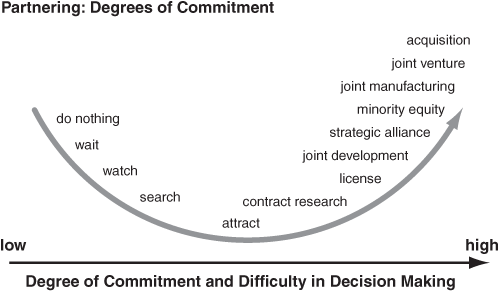Partnering Strategies
Partnering is the cornerstone of open innovation. Partnering also includes alliances with internal groups globally, but the main focus here is external groups. Partnering with other groups spans a wide spectrum of options, as indicated in Exhibit 9.2.
Exhibit 9.2. Partnering Options

It is noteworthy that as the degree of commitment increases, so does the difficulty of decision making; more is at stake. The spectrum ranges from “do nothing” to “acquisition,” with many options in between.
Where does partnering fit in the innovation pipeline? Innovations can be characterized as consisting of five stages: concept, feasibility, prototype, development, and commercialization. External partnering typically occurs during the concept and feasibility stages, but partnering can also certainly occur in the development and commercialization stages (e.g., joint venture, joint manufacturing, acquisition).
We have found some general guidelines in selecting the right partner across the spectrum of commitment:
Identify compelling value brought by partner.
Create clear incentive for collaboration.
Define scope: what’s included.
Define roles: who does what.
Contract with clear dollar amounts and schedule.
Define process for joint decision making when issues come up.
Build trust.
Mutual understanding of the “win-win” with well-defined responsibilities, project scope, and budget is ...
Get Innovate or Perish: Managing the Enduring Technology Company in the Global Market now with the O’Reilly learning platform.
O’Reilly members experience books, live events, courses curated by job role, and more from O’Reilly and nearly 200 top publishers.

